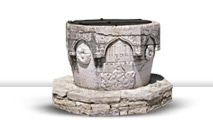
- Sečovlje Salt Pans - Dragonja River Valley
- Sv. Peter - Nova vas - Padna
- Pomjan - Nature Park: Karst Edge - Socerb
- Črni Kal - Osp - Kubed
- Momjan - Grožnjan - Pietrapelosa - Mirna
- Baštija - Kostanjica - Parenzana
- Oprtalj - Završje - Livade - Zrenj
- Istarske toplice - Motovun Forest - Višnjan
- Cave Mramornica - Feštini Kingdom - Cave Baredine
- Lim Bay - Kloštar - Kontija - Dvigrad
- Kanfanar - Bale - Palud - Vodnjan - Brijuni - Fažana
- Svetvinčenat - Tinjan - Pićan - Gračišće
- Belaj - Šumber - Kožljak - Paz
- Čepićko Field - Kršan - Boljun Castle - Lupoglav
- Plomin - Kvarner Gulf - Brseč
- Nature park Učka - Mošćenice
Belaj - Šumber - Kožljak - Paz
Kožljak
It is situated on the western slopes of Mount Učka, opposite the lowest mountain ridge, over which the road to the Liburnian coast passed in Roman times and the Middle Ages, on the site of the prominent steep, isolated elevation.
A castle was built on this elevation in the Middle Ages, mentioned in documents in the beginning of the 12th c. under the Croatian name Iosilach or Gosilach when it became the fief of the Patriarchs of Aquileia. The castle, only ruins of which remain on the plateau of that solid rock, is the last of a series of fortified feudal residences stretching from the Trieste Karst along the western slopes of Ćićarija and Učka. In time, new Kožljak emerged below the old castle, town which apart from the name took over the tradition, history and past of the former town-fortress.
Ruins of the castle from the 11th c., St. George's Church from the 16th c. and the Church of the Holy Cross from the 18th c. are a reminder of the economic and religious life of this area.

















